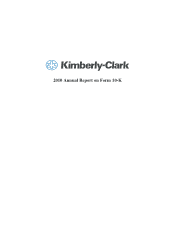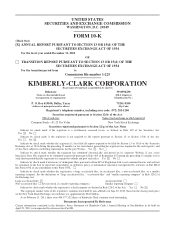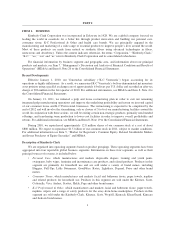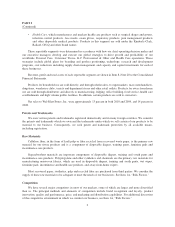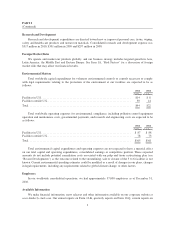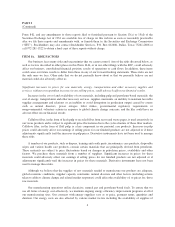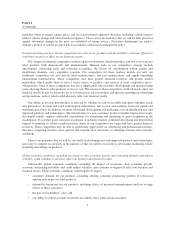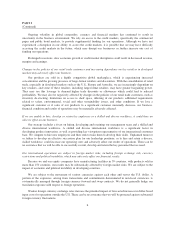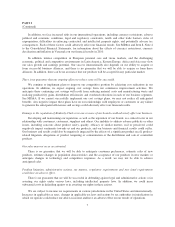Kimberly-Clark 2010 Annual Report Download - page 6
Download and view the complete annual report
Please find page 6 of the 2010 Kimberly-Clark annual report below. You can navigate through the pages in the report by either clicking on the pages listed below, or by using the keyword search tool below to find specific information within the annual report.
PART I
(Continued)
•Health Care, which manufactures and markets health care products such as surgical drapes and gowns,
infection control products, face masks, exam gloves, respiratory products, pain management products
and other disposable medical products. Products in this segment are sold under the Kimberly-Clark,
Ballard, ON-Q and other brand names.
These reportable segments were determined in accordance with how our chief operating decision maker and
our executive managers develop and execute our global strategies to drive growth and profitability of our
worldwide Personal Care, Consumer Tissue, K-C Professional & Other and Health Care operations. These
strategies include global plans for branding and product positioning, technology, research and development
programs, cost reductions including supply chain management, and capacity and capital investments for each of
these businesses.
Revenue, profit and total assets of each reportable segment are shown in Item 8, Note 20 to the Consolidated
Financial Statements.
Products for household use are sold directly, and through wholesalers, to supermarkets, mass merchandisers,
drugstores, warehouse clubs, variety and department stores and other retail outlets. Products for away-from-home
use are sold through distributors and directly to manufacturing, lodging, office building, food service, health care
establishments and high volume public facilities. In addition, certain products are sold to converters.
Net sales to Wal-Mart Stores, Inc. were approximately 13 percent in both 2010 and 2009, and 14 percent in
2008.
Patents and Trademarks
We own various patents and trademarks registered domestically and in many foreign countries. We consider
the patents and trademarks which we own and the trademarks under which we sell certain of our products to be
material to our business. Consequently, we seek patent and trademark protection by all available means,
including registration.
Raw Materials
Cellulose fiber, in the form of kraft pulp or fiber recycled from recovered waste paper, is the primary raw
material for our tissue products and is a component of disposable diapers, training pants, feminine pads and
incontinence care products.
Superabsorbent materials are important components of disposable diapers, training and youth pants and
incontinence care products. Polypropylene and other synthetics and chemicals are the primary raw materials for
manufacturing nonwoven fabrics, which are used in disposable diapers, training and youth pants, wet wipes,
feminine pads, incontinence and health care products, and away-from-home wipers.
Most recovered paper, synthetics, pulp and recycled fiber are purchased from third parties. We consider the
supply of these raw materials to be adequate to meet the needs of our businesses. See Item 1A, “Risk Factors.”
Competition
We have several major competitors in most of our markets, some of which are larger and more diversified
than us. The principal methods and elements of competition include brand recognition and loyalty, product
innovation, quality and performance, price, and marketing and distribution capabilities. For additional discussion
of the competitive environment in which we conduct our business, see Item 1A, “Risk Factors.”
2

